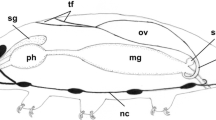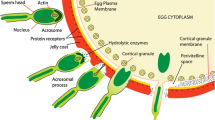Summary
The immunocytochemical localization of the egg-jelly macromolecule, a fucose sulphate glycoconjugate (FSG) that induces the acrosome reaction in spermatozoa, was investigated in ovaries of the sea urchin Hemicentrotus pulcherrimus by use of a polyclonal antibody. The polyclonal antibody reacted with the accessory cells and oocytes in the ovarian lumen. In the accessory cells, evidence of an intense immunohistochemical reaction was observed in many globules of variable density. Products of the specific immunohistochemical reaction were frequently observed in the surface region of oocytes, at a distance from the ovarian wall. At the ultrastructural level, the polyclonal antibody was found to react with the material present in the vacuole-like structures of the globules in the accessory cells. Many gold particles, demonstrating specific immunolabelling, were associated with well-developed microvilli on the vitellogenic oocytes. In the mature oocytes, intense labelling was observed in the jelly coat but not in the vitelline coat. By contrast, oogonia and early oocytes were barely labelled. Quantitative data indicated that the extent of immunolabellings in the surface region of oocytes was very high in the vitellogenic and mature oocytes. In all cases, neither the oocyte cytoplasm nor the subcellular organelles were labelled. These results suggest that FSG is produced by the accessory cells and is deposited initially on the surface of vitellogenic oocytes for the formation of jelly. These findings may provide a new insight into the role of the accessory cells in the reproductive process of the sea urchin.
Similar content being viewed by others
References
Abe H, Oikawa T (1990a) Study of the differentiation of secretony cells in the golden hamster oviductal epithelium by use of a monoclonal antibody. J Exp Zool 254:97–106
Abe H, Oikawa T (1990b) Ultrastructural evidence for an association between an oviductal glycoprotein and the zona pellucida of the golden hamster egg. J Exp Zool 256:210–221
Abe H, Oikawa T (1991) Immunocytochemical localization of an oviductal zona pellucida glycoprotein in the oviductal epithelium of the golden hamster. Anat Rec 229:305–314
Bal AK (1970) Ultrastructural changes in the accessory cells and the oocyte surface of the sea urchin Strongylocentrotus droebachiensis during vitellogenesis. Z Zellforsch 111:1–14
Bleil JD, Wassarman PM (1980) Synthesis of zona pellucida proteins by denuded and follicle-enclosed mouse oocytes duringculture in vitro. Proc Natl Acad Sci USA 77:1029–1033
Chatlynne LG (1969) A histochemical study of oogenesis in the sea urchin, Strongylocentrotus purpuratus. Biol Bull 136:167–184
Christen R, Schackmann RW, Shapiro BM (1983) Interaction between sperm and sea urchin egg jelly. Dev Biol 98:1–14
Collins F, Epel D (1977) The role of calcium ions in the acrosome reaction of sea urchin sperm. Exp Cell Res 106:211–222
Dan JC (1952) Studies of the acrosome: I. Reaction to egg-water and other stimuli. Biol Bull 103:54–66
Dan JC (1954) Studies of the acrosome: II. Effects of calcium deficiency. Biol Bull 107:335–349
Dan JC (1956) The acrosome reaction. Int Rev Cytol 5:365–393
Decker GL, Joseph DB, Lennarz WJ (1976) A study of factors involved in induction of the acrosome reaction in sperm of the sea urchin, Arbacia punctulata. Dev Biol 53:115–125
Epel D (1978) Mechanisms of activation of sperm and egg during fertilization of sea urchin gamates. Curr Top Dev Biol 12:185–246
Fuji A (1960) Studies on the biology of the sea urchin: I. Superficial and histological gonadal changes in the gametogenic process of two sea urchins, Strongylocentrotus nudus and S. intermedius. Bull Fac Fish Hokkaido Univ 11:1–14
Gathers DL, Kopf GS (1980) The regulation of spermatozoa by calcium and cyclic nucleotides. Adv Cyclic Nucleotide Res 13:251–306
Garbers DL, Watkins HD, Hansbrough JR, Misono KS (1982) The amino acid sequence and chemical synthesis of speract and of speract analogues. J Biol Chem 257:2734–2737
Garbers DL, Kopf GS, Tubb DJ, Olson G (1983) Elevation of sperm adenosine 3′:5′-monophosphate concentrations by a fucose-sulfate-rich complex associated with eggs: I. Structural characterization. Biol Reprod 29:1211–1220
Green GR, Poccia DL (1985) Phosphorylation of sea urchin sperm H1 and H2B histones precedes chromatin decondensation and H1 exchange during pronuclear formation. Dev Biol 108:235–245
Greve JM, Salzmann GS, Roller RJ, Wassarman PM (1982) Biosynthesis of the major zona pellucida glycoprotein secreted by oocytes during mammalian oogenesis. Cell 31:749–759
Hotta K, Hamazaki H, Kurokawa M, Isaka S (1970) Isolation and properties of a new type of sialopolysaccharide protein complex from the jelly coat of sea urchin eggs. J Biol Chem 245:5434–5440
Isaka S, Hotta K, Kurokawa M (1970) Jelly coat substances of sea urchin eggs. Exp Cell Res 59:37–42
Ishihara K, Oguri K, Taniguchi H (1973) Isolation and characterization of fucose sulfate from jelly coat glycoprotein of sea urchin egg. Biochem Biophys Acta 320:629–634
Jaffe LA, Gould M (1985) Polyspermy-preventing mechanisms. In: Metz CB, Monroy A (eds) Biology of fertilization, vol 1. Academic Press, New York, pp 223–250
Jondeung A, Czihak G (1982) Histochemical studies of jelly coat of sea-urchin eggs during oogenesis. Histochemistry 76:123–136
Jondeung A, Czihak G (1983) Histochemical study of globules in accessory cells of sea urchin ovary: In relation to jelly coat substance. Acta Histochem 73:9–15
Katagiri C (1987) Role of oviducal secretions in mediating gamete fusion in anuran amphibians. Zool Sci 4:1–14
Kinsey WH, SeGall GK, Lennarz WJ (1979) The effect of the acrosome reaction on the respiratory activity and fertilizing capacity of echinoid sperm. Dev Biol 71:49–59
Kinsey WH, Rubin JA, Lennarz WJ (1980) Studies on the specificity of sperm binding in echinoderm fertilization. Dev Biol 74:245–250
Kopf GS, Garbers DL (1980) Calcium and fucose-sulfate-rich polymer regulate sperm cyclic nucleotide metabolism and the acrosome reaction. Biol Reprod 22:1118–1126
Masuda R, Dan JC (1977) Studies on the annual reproductive cycle of the sea urchin and the acid phosphatase. Biol Bull 153:577–590
Monroy A, Rosati F (1983) A comparative analysis of sperm-egg interaction. Gamete Res 7:85–102
Moy GW, Vacquier VD (1979) Immunoperoxidase localization of bindin during the adhesion of sperm to sea urchin eggs. Curr Top Dev Biol 13:31–44
Ohtake H (1976) Respiratory behaviour of sea-urchin spermatozoa: I. Effect of pH and egg water on the respiratory rate. J Exp Zool 198:303–312
Oikawa T, Sendai Y, Kurata S, Yanagimachi R (1988) A glycoprotein of oviductal origin alters biochemical properties of the zona pellucida of hamster egg. Gamete Res 19:113–122
Porter DC, Vacquier VD (1986) Phosphorylation of sperm histone H1 is induced by the egg jelly layer in the sea urchin Stronglylocentrotus purpuratus. Dev Biol 116:203–212
Porter DC, Moy GW, Vacquier VD (1988) cAMP-dependent protein kinase of sea urchin sperm phosphorylates sperm historic H1 on a single site. J Biol Chem 263:2750–2755
Rosati F, Cotelli F, Santis R de, Monroy A, Pinto MR (1982) Synthesis of fucosyl-containing glycoproteins of the vitelline coat in oocytes of Ciona intestinalis (Ascidia). Proc Natl Acad Sci USA 79:1908–1911
Santella L, Monroy A, Rosati F (1983) Studies on the differentiation of egg envelopes: I. The starfish, Astropecten aurantiacus. Dev Biol 99:473–481
Schmell ED, Gulyas BJ, Hedrick JL (1983) Egg surface changes during fertilization and the molecular mechanism of the block to polyspermy. In: Hartman JF (ed) Mechanism and control of animal fertilization. Academic Press, New York, pp 365–413
SeGall GK, Lennarz WJ (1979) Chemical characterization of the component of the egg jelly coat from sea urchin eggs resposible for induction of the acrosome reaction. Dev Biol 71:33–48
SeGall GK, Lennarz WJ (1981) Jelly coat induction of the acrosome reaction in echinoid sperm. Dev Biol 86:87–93
Shimizu T, Kinoh H, Yamaguchi M, Suzuki N (1990) Purification and characterization of the egg jelly macromolecules, sialoglycoprotein and fucose sulfate glycoconjugate, of the sea urchin Hemicentrotus pulcherrimus. Dev Growth Differ 32:473–487
Summers RG, Hylander BL (1975) Species-specificity of reaction and primary gamete binding in echinoids. Exp Cell Res 93:63–98
Summers RG, Hylander BL, Colwin LH, Colwin AL (1975) The functional anatomy of the echinoderm spermatozoon and its interaction with the egg at fertilization. Am Zool 15:523–551
Suzuki N (1989) Sperm-activating peptides from sea urchin egg jelly. In: Scheuer PJ (ed) Bioorganic marine chemistry, vol 3. Springer, Berlin Heidelberg New York, pp 47–70
Suzuki N, Nomura K, Ohtake H, Isaka S (1981) Purification and the primary structure of sperm-activating peptides from the jelly coat of sea urchin eggs. Biochem Biophys Res Commun 99:1238–1244
Suzuki N, Kobayashi K, Isaka S (1982) Appearance of sperm activation factors in the ovary of the sea urchin Hemicentrotus pulcherrimus with maturation. Experientia 38:1245–1246
Takashima Y (1976) Ultrastructure of nurse cells and oogenesis in the sea urchin. Gunma Symp Endocrinol 13:105–127
Tilney LG, Hatano S, Ishikawa H, Mooseker MS (1973) The polymerization of actin: Its role in the generation of the acrosomal process of certain echinoderm sperm. J Cell Biol 59:109–126
Verhey CA, Moyer FH (1967) Fine structural changes during sea urchin oogenesis. J Exp Zool 164:195–226
Wassarman PM (1990) Profile of a mammalian sperm receptor. Development 108:1–17
Wolgemuth DJ, Celenza J, Bundman DS, Dunber BS (1984) Formation of the rabbit zona pellucida and its relationship to ovarian follicular development. Dev Biol 106:1–14
Yamaguchi M, Kurita M, Suzuki N (1989a) Induction of the acrosome reaction of Hemicentrotus pulcherrimus spermatozoa by the egg jelly molecules, fucose-rich glycoconjugate and sperm-activating peptides I. Dev Growth Differ 31:233–239
Yamaguchi S, Hedrick JL, Katagiri C (1989b) The synthesis and localization of envelope glycoproteins in oocytes of Xenopus laevis using immunocytochemical methods. Dev Growth Differ 31:85–94
Author information
Authors and Affiliations
Additional information
Offprint requests to: N. Suzuki
Rights and permissions
About this article
Cite this article
Abe, H., Kinoh, H., Oikawa, T. et al. The egg-jelly macromolecule, a fucose sulphate glycoconjugate, originates from the accessory cells of the ovary in the sea urchin Hemicentrotus pulcherrimus . Roux's Arch Dev Biol 201, 179–189 (1992). https://doi.org/10.1007/BF00188717
Received:
Accepted:
Issue Date:
DOI: https://doi.org/10.1007/BF00188717




